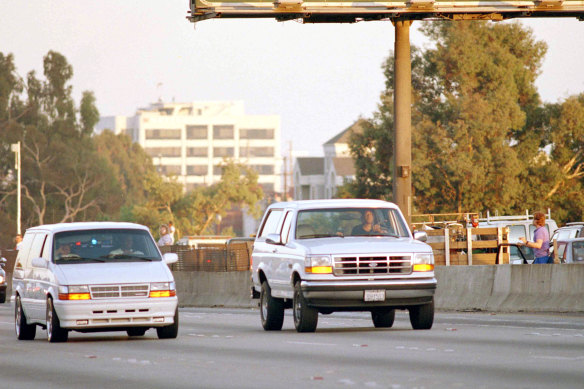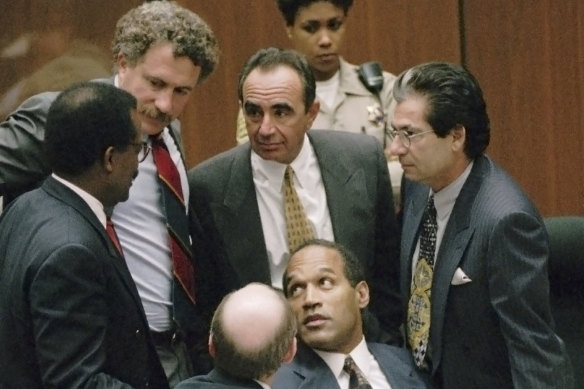
The generations-old chasm between white Americans and black Americans was not helped by Time magazine’s decision to tactically darken Simpson’s mugshot on its cover for dramatic – and, many said, racist – effect. For those who lived through that period, it’s hard to remember much in the public sphere that wasn’t crowded out by the O.J. storyline and its many components, including the subsequent civil trial that found Simpson liable for the deaths. One newspaper even ran a series of possible endings to the storyline, written by mystery novelists.
Sure, people were saying different things. But it was, inarguably, a national conversation.

Al Cowlings, with O.J. Simpson hiding, drives a white Ford Bronco as they lead police on a two-county chase along the northbound 405 Freeway towards Simpson’s home on June 17, 1994.Credit: AP
The nation – and its media – are far more fragmented now. Rarely these days do Americans gather around the virtual campfire for a common experience; instead, small brush fires draw niche crowds in virtual corners for equally intense, but smaller, common experiences. This week’s eclipse was a rare exception.
In 1994, everyday real-time, wall-to-wall coverage was still emerging. Sure, we had Walter Cronkite during the Kennedy assassination and again during the chaotic 1968 Democratic National Convention. And the first Gulf War in 1991 firmly cemented live TV expectations. But coverage of the Bronco chase and the trial fed the appetite in a way no other event did. Even now, such universal viewership is rare.
“The media we consume is much more diffuse now. It’s so rare that we’re all glued to the same spectacle,” said Danielle Lindemann, author of the 2022 book True Story: What Reality TV Says About Us.
“In 1994 we were watching our television sets and following along with news coverage,” Lindemann, a professor of sociology at Lehigh University in Bethlehem, Pennsylvania, said in an email. “But there wasn’t that parallel discourse happening via social media.”

O.J. Simpson is surrounded by his lawyers (clockwise from left) Johnnie L. Cochran Jr, Peter Neufeld, Robert Shapiro, Robert Kardashian and Robert Blasier.Credit: AP
Connections between then and now
The connections between the Simpson saga and today aren’t hard to find.
Judges and lawyers in high-profile cases are now regular fodder for the spotlight. One of Simpson’s attorneys, Robert Kardashian, paved the way for the next generation of his family to change the very face of how celebrity operates. A local Los Angeles TV reporter who covered the case, Harvey Levin, went on to establish TMZ, a luridly foundational pillar of modern multiplatform celebrity coverage – and the outlet that broke the news of Simpson’s death.
And of course, as with so many American stories, there is the question of race.
Simpson’s acquittal on murder charges revealed a fundamental fault line: some black people welcomed the verdict, while many white people were in disbelief. Simpson probably confused matters more over the years by saying, famously, “I’m not black. I’m O.J.” But for many black Americans who felt their interactions with police and the courts had produced unjust results, the acquittal was a notable exception.
“There was a sense that it’s only justice for a rich black man to get off when a rich white man would,” said John Baick, a professor of history at Western New England University.
Three decades on, that conversation isn’t over – he’s certainly still discussing it with students. On Thursday, Baick invoked Simpson to talk about race, fame and wealth in class; only after it ended did he find out his subject had died.
Loading
A generation has passed since these events were fresh. And after thousands of hours of video, millions of written words and countless talking heads weighing in, the O.J. Simpson case stands as two things: an American moment like no other, and an interlude that contained so much of what American culture is and was becoming.
From the old, weird America, it got the obsession with violent true crime and its quirky cast of film noir villains and heroes, not to mention the tragedy and the whodunit. And it was a teaser trailer of the emerging, fragmenting internet culture that would, in a few years, give us smartphones, social media, reality-TV saturation and live coverage of just about everything.
Was it, as so many said so loudly, “the trial of the century”? That’s subjective. But any culture is made up of small bits, and the Simpson case left many of those in its wake. This much is incontrovertibly true: after the slow-speed chase, American media culture got a whole lot faster really quickly. So fast, in fact, that many of the central questions around the case – about race, justice and how we consume murder and misery as just another set of consumer products – linger unanswered.
“Where does this fit in? What do Americans think about this now?” Baick wonders. “What you think about O.J. Simpson might be a litmus test for a long time still.”
AP
Get a note directly from our foreign correspondents on what’s making headlines around the world. Sign up for the weekly What in the World newsletter here.